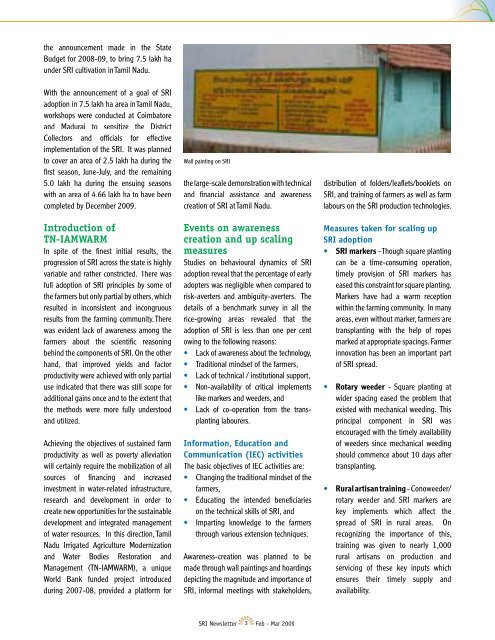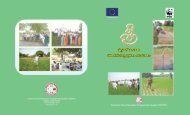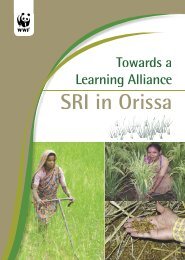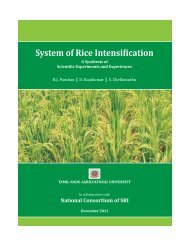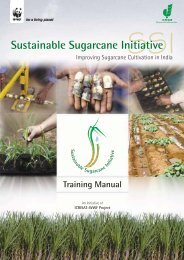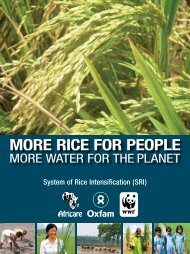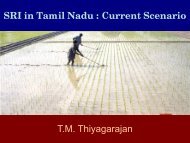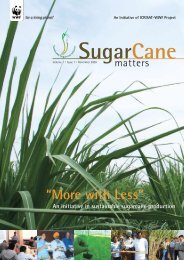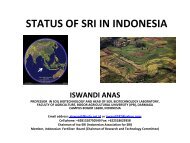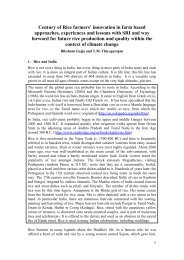Stretching Out SRI in Tamil Nadu - SRI - India
Stretching Out SRI in Tamil Nadu - SRI - India
Stretching Out SRI in Tamil Nadu - SRI - India
Create successful ePaper yourself
Turn your PDF publications into a flip-book with our unique Google optimized e-Paper software.
the announcement made <strong>in</strong> the State<br />
Budget for 2008-09, to br<strong>in</strong>g 7.5 lakh ha<br />
under <strong>SRI</strong> cultivation <strong>in</strong> <strong>Tamil</strong> <strong>Nadu</strong>.<br />
With the announcement of a goal of <strong>SRI</strong><br />
adoption <strong>in</strong> 7.5 lakh ha area <strong>in</strong> <strong>Tamil</strong> <strong>Nadu</strong>,<br />
workshops were conducted at Coimbatore<br />
and Madurai to sensitize the District<br />
Collectors and officials for effective<br />
implementation of the <strong>SRI</strong>. It was planned<br />
to cover an area of 2.5 lakh ha dur<strong>in</strong>g the<br />
first season, June-July, and the rema<strong>in</strong><strong>in</strong>g<br />
5.0 lakh ha dur<strong>in</strong>g the ensu<strong>in</strong>g seasons<br />
with an area of 4.66 lakh ha to have been<br />
completed by December 2009.<br />
Introduction of<br />
TN-IAMWARM<br />
In spite of the f<strong>in</strong>est <strong>in</strong>itial results, the<br />
progression of <strong>SRI</strong> across the state is highly<br />
variable and rather constricted. There was<br />
full adoption of <strong>SRI</strong> pr<strong>in</strong>ciples by some of<br />
the farmers but only partial by others, which<br />
resulted <strong>in</strong> <strong>in</strong>consistent and <strong>in</strong>congruous<br />
results from the farm<strong>in</strong>g community. There<br />
was evident lack of awareness among the<br />
farmers about the scientific reason<strong>in</strong>g<br />
beh<strong>in</strong>d the components of <strong>SRI</strong>. On the other<br />
hand, that improved yields and factor<br />
productivity were achieved with only partial<br />
use <strong>in</strong>dicated that there was still scope for<br />
additional ga<strong>in</strong>s once and to the extent that<br />
the methods were more fully understood<br />
and utilized.<br />
Achiev<strong>in</strong>g the objectives of susta<strong>in</strong>ed farm<br />
productivity as well as poverty alleviation<br />
will certa<strong>in</strong>ly require the mobilization of all<br />
sources of f<strong>in</strong>anc<strong>in</strong>g and <strong>in</strong>creased<br />
<strong>in</strong>vestment <strong>in</strong> water-related <strong>in</strong>frastructure,<br />
research and development <strong>in</strong> order to<br />
create new opportunities for the susta<strong>in</strong>able<br />
development and <strong>in</strong>tegrated management<br />
of water resources. In this direction, <strong>Tamil</strong><br />
<strong>Nadu</strong> Irrigated Agriculture Modernization<br />
and Water Bodies Restoration and<br />
Management (TN-IAMWARM), a unique<br />
World Bank funded project <strong>in</strong>troduced<br />
dur<strong>in</strong>g 2007-08, provided a platform for<br />
Wall pa<strong>in</strong>t<strong>in</strong>g on <strong>SRI</strong><br />
the large-scale demonstration with technical<br />
and f<strong>in</strong>ancial assistance and awareness<br />
creation of <strong>SRI</strong> at <strong>Tamil</strong> <strong>Nadu</strong>.<br />
Events on awareness<br />
creation and up scal<strong>in</strong>g<br />
measures<br />
Studies on behavioural dynamics of <strong>SRI</strong><br />
adoption reveal that the percentage of early<br />
adopters was negligible when compared to<br />
risk-averters and ambiguity-averters. The<br />
details of a benchmark survey <strong>in</strong> all the<br />
rice-grow<strong>in</strong>g areas revealed that the<br />
adoption of <strong>SRI</strong> is less than one per cent<br />
ow<strong>in</strong>g to the follow<strong>in</strong>g reasons:<br />
• Lack of awareness about the technology,<br />
• Traditional m<strong>in</strong>dset of the farmers,<br />
• Lack of technical / <strong>in</strong>stitutional support,<br />
• Non-availability of critical implements<br />
like markers and weeders, and<br />
• Lack of co-operation from the transplant<strong>in</strong>g<br />
labourers.<br />
Information, Education and<br />
Communication (IEC) activities<br />
The basic objectives of IEC activities are:<br />
• Chang<strong>in</strong>g the traditional m<strong>in</strong>dset of the<br />
farmers,<br />
• Educat<strong>in</strong>g the <strong>in</strong>tended beneficiaries<br />
on the technical skills of <strong>SRI</strong>, and<br />
• Impart<strong>in</strong>g knowledge to the farmers<br />
through various extension techniques.<br />
Awareness-creation was planned to be<br />
made through wall pa<strong>in</strong>t<strong>in</strong>gs and hoard<strong>in</strong>gs<br />
depict<strong>in</strong>g the magnitude and importance of<br />
<strong>SRI</strong>, <strong>in</strong>formal meet<strong>in</strong>gs with stakeholders,<br />
<strong>SRI</strong> Newsletter 3 Feb - Mar 2009<br />
distribution of folders/leaflets/booklets on<br />
<strong>SRI</strong>, and tra<strong>in</strong><strong>in</strong>g of farmers as well as farm<br />
labours on the <strong>SRI</strong> production technologies.<br />
Measures taken for scal<strong>in</strong>g up<br />
<strong>SRI</strong> adoption<br />
• <strong>SRI</strong> markers - Though square plant<strong>in</strong>g<br />
can be a time-consum<strong>in</strong>g operation,<br />
timely provision of <strong>SRI</strong> markers has<br />
eased this constra<strong>in</strong>t for square plant<strong>in</strong>g.<br />
Markers have had a warm reception<br />
with<strong>in</strong> the farm<strong>in</strong>g community. In many<br />
areas, even without marker, farmers are<br />
transplant<strong>in</strong>g with the help of ropes<br />
marked at appropriate spac<strong>in</strong>gs. Farmer<br />
<strong>in</strong>novation has been an important part<br />
of <strong>SRI</strong> spread.<br />
• Rotary weeder - Square plant<strong>in</strong>g at<br />
wider spac<strong>in</strong>g eased the problem that<br />
existed with mechanical weed<strong>in</strong>g. This<br />
pr<strong>in</strong>cipal component <strong>in</strong> <strong>SRI</strong> was<br />
encouraged with the timely availability<br />
of weeders s<strong>in</strong>ce mechanical weed<strong>in</strong>g<br />
should commence about 10 days after<br />
transplant<strong>in</strong>g.<br />
• Rural artisan tra<strong>in</strong><strong>in</strong>g - Conoweeder/<br />
rotary weeder and <strong>SRI</strong> markers are<br />
key implements which affect the<br />
spread of <strong>SRI</strong> <strong>in</strong> rural areas. On<br />
recogniz<strong>in</strong>g the importance of this,<br />
tra<strong>in</strong><strong>in</strong>g was given to nearly 1,000<br />
rural artisans on production and<br />
servic<strong>in</strong>g of these key <strong>in</strong>puts which<br />
ensures their timely supply and<br />
availability.


